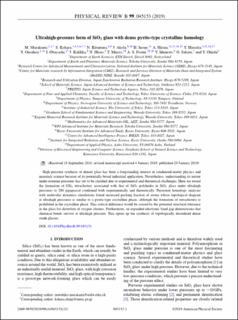| dc.contributor.author | Murakami, M. | |
| dc.contributor.author | Kohara, S | |
| dc.contributor.author | Kitamura, N. | |
| dc.contributor.author | Akola, Jaakko | |
| dc.contributor.author | Inoue, H | |
| dc.contributor.author | Hirata, A | |
| dc.contributor.author | Hiraoka, Y | |
| dc.contributor.author | Onodera, Y | |
| dc.contributor.author | Obayashi, I | |
| dc.contributor.author | Kalikka, J | |
| dc.contributor.author | Hirao, N | |
| dc.contributor.author | Musso, T | |
| dc.contributor.author | Foster, Adam S | |
| dc.contributor.author | Idemoto, Y | |
| dc.contributor.author | Sakata, O | |
| dc.contributor.author | Ohishi, Y | |
| dc.date.accessioned | 2020-04-07T07:28:16Z | |
| dc.date.available | 2020-04-07T07:28:16Z | |
| dc.date.created | 2019-11-06T16:26:42Z | |
| dc.date.issued | 2019 | |
| dc.identifier.issn | 2469-9950 | |
| dc.identifier.uri | https://hdl.handle.net/11250/2650573 | |
| dc.description.abstract | High-pressure synthesis of denser glass has been a longstanding interest in condensed-matter physics and materials science because of its potentially broad industrial application. Nevertheless, understanding its nature under extreme pressures has yet to be clarified due to experimental and theoretical challenges. Here we reveal the formation of OSi4 tetraclusters associated with that of SiO7 polyhedra in SiO2 glass under ultrahigh pressures to 200 gigapascal confirmed both experimentally and theoretically. Persistent homology analyses with molecular dynamics simulations found increased packing fraction of atoms whose topological diagram at ultrahigh pressures is similar to a pyrite-type crystalline phase, although the formation of tetraclusters is prohibited in the crystalline phase. This critical difference would be caused by the potential structural tolerance in the glass for distortion of oxygen clusters. Furthermore, an expanded electronic band gap demonstrates that chemical bonds survive at ultrahigh pressure. This opens up the synthesis of topologically disordered dense oxide glasses | en_US |
| dc.language.iso | eng | en_US |
| dc.publisher | American Physical Society | en_US |
| dc.title | Ultrahigh-pressure form of Si O2 glass with dense pyrite-type crystalline homology | en_US |
| dc.type | Peer reviewed | en_US |
| dc.type | Journal article | en_US |
| dc.description.version | publishedVersion | en_US |
| dc.source.volume | 99 | en_US |
| dc.source.journal | Physical review B (PRB) | en_US |
| dc.source.issue | 4 | en_US |
| dc.identifier.doi | 10.1103/PhysRevB.99.045153 | |
| dc.identifier.cristin | 1744687 | |
| dc.description.localcode | © American Physical Society 2019. | en_US |
| cristin.unitcode | 194,66,20,0 | |
| cristin.unitname | Institutt for fysikk | |
| cristin.ispublished | true | |
| cristin.fulltext | original | |
| cristin.qualitycode | 2 | |
